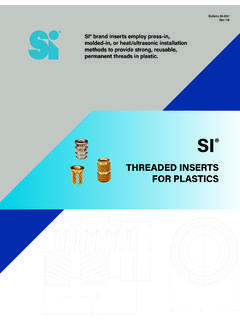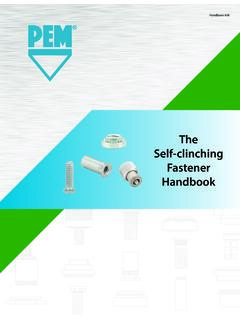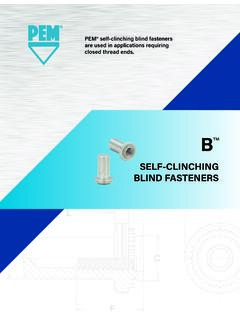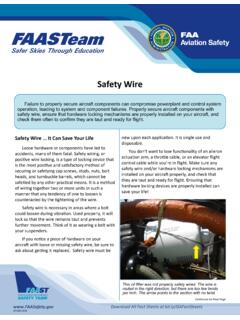Transcription of SELF-LOCKING FASTENERS
1 LN SELF-LOCKINGFASTENERSPEM self-clinching locknuts prevent mating hardware from LN-218LN-2 PennEngineering FASTENERSPEM SELF-CLINCHING LOCKNUTS PREVENT MATING HARDWARE FROM LOOSENINGPEM self-clinching locknuts provide ideal solutions to prevent mating hardware from loosening in service due to vibration or other application-related factors. This family of FASTENERS includes a variety of types and different locking-feature styles to satisfy a wide range of applications. Their use can save time and money compared with alternative chemical locking methods or LOCKING THREADSPEM locknuts include two locking designs:1) PREVAILING torque (CFN , FE , FEO , UL , LAS , LAC , LA4 , LK , LKS , LKA , PL , PLC and SL locknuts) a design feature of the lock nut produces friction between threads of mated components thereby increasing the force needed to tighten as well as loosen the nut.
2 Prevailing torque locknuts provide essentially the same torque value regardless of the amount of axial load applied. Available in two types: All metal All PEM metal prevailing torque type locknuts achieve their prevailing torque by altering the shape of the nut in some way - most commonly by distorting the threads of the nut, which then grips the mating part during tightening. Screws for use with PEM prevailing torque locknuts should be Class 3A/4h fit or no smaller than Class 2A/6g. Available in three styles: Elliptically squeezed threads (UL , FE , FEO , LAC , LAS and LA4 locknuts) the thread barrel is slightly deformed into an elliptical shape. Flexing jaws (LK , LKS and LKA locknuts) - the thread barrel is vertically slit and then the two sections are squeezed together.
3 One or two deformed threads (SL locknuts) - the last threads on the head side of the nut are prevailing torque locknuts utilizing a metal locking feature are treated with a dry film lubricant coating to afford some level of lubricity to reduce damage to the threads from repeated installation and removal of the screw and reduce required tightening torque . Care should be taken to be sure that lubricant is not removed in any post installed finishing operations. Nylon insertThe PL , PLC and CFN locknuts use a plastic insert, typically made from nylon to generate the torque resistance. A nylon ring is attached to the self-clinching body on the screw exit side with an ID approximately at the screw pitch diameter. As the screw enters this ring, there is interference at the major diameter generating a prevailing torque .
4 The major advantage of this locking method is the greatly reduced chance of any conductive debris being generated by repeated installation and removal of the ) FREE-RUNNING (S-RT locknuts) a nut that requires tightening against a bearing surface in order for the locking mechanism to function. If the tightening force (clamp load) is removed for any reason, these nuts no longer provide any torsional resistance to rotation. The modified thread formation allows mating screws to spin freely during the attachment process until clamp load is induced during the screw-tightening free-running locknuts will accept a maximum material 6g/2A FASTENERSPennEngineering LN-3 CFN broaching FASTENERS are available for thinner sheet, close-to-edge applications. The nylon locking element provides prevailing torque to eliminate loosening of mating threaded hardware - PAGE 4FE /FEO /UL miniature locking nuts, provide a smaller body for tight space, lightweight applications - PAGE 5 LAS /LAC /LA4 nuts with SELF-LOCKING , floating threads that permit up to.
5 030 mm adjustment for mating hole misalignment - PAGE 6LK /LKS /LKA nuts have a rugged PEMFLEX SELF-LOCKING feature which meets demanding locking performance requirements - PAGE 7PL /PLC PEMHEX nuts with a nylon hexagonal element provide a locking option for applications where a metal on metal locking feature is not desired - PAGE 8S L locknuts offer a cost effective TRI-DENT locking feature and effective prevailing locking torque - PAGE 9S-RT locknuts are free-running until clamp load is induced. A modified thread angle on the loaded flank provides the vibration resistant locking feature- PAGE 10 Material and finish specifications - PAGES 11 Installation - PAGES 12 - 15 Performance data - PAGES 16 - 20 Nylon InsertEllipticallySqueezed ThreadsEllipticallySqueezed ThreadsFlexing JawsNylon InsertDeformed Threads CFN 4 1 (6) FE 5 15(3) (7) FEO 5 15(3)
6 (7) UL 5 5(4) (7) LAS 6 15(3) (7) LAC 6 15(3) (7) LA4(2) 6 15(3) (7) LK 7 15(3)
7 (7) LKS 7 15(3) (7) LKA 7 15(3) (9) PL 8 15(3) (6) PLC 8 15(3) (6) SL 9 3 (8) S-RT 10 (5) (8)LOCKING NUT SELECTOR GUIDE PEM Page Locking No.
8 Nut Application Features Locking Non-metal Locking High Close-to- Performance on Metal Covered by (1) Performance Clamp Floating Light edge Temperature Locking Locking Cycles Strength Threads Weight Applications Limit Feature Style M45938/7 M45938/11(1) To meet national aerospace standards and to obtain testing documentation, product must be ordered using appropriate NASM45938 part number. Check our web site for a complete Military Specification and National Aerospace Standards Reference Guide (Bulletin NASM).(2) Specifically designed to be installed into stainless steel sheets.
9 (3) See page 19 for information on NASM25027 as applied to PEM self-clinching, SELF-LOCKING nuts.(4) Meets torque requirements for NASM25027 through five cycles.(5) Locking performance is not affected by the number of on/off cycles.(6) Nylon locking element temperature limit is 250 F / 120 C.(7) Dry film lubricant rated for use up to 400 F / 204 C.(8) The fastening strength of the locknut is maintained up to 800 F / 426 C. Temperatures above 300 F / 149 C will dehydrate the conversion coating.(9) Aluminum material temperature limit is 250 F / 120 InsertElliptically SqueezedElliptically SqueezedElliptically SqueezedElliptically SqueezedElliptically SqueezedElliptically SqueezedFlexing JawsFlexing JawsFlexing JawsNylon InsertNylon InsertDeformed ThreadsFree-running ThreadsNEW!
10 Free-runningThreadsLN-4 PennEngineering FASTENERSMETRICUNIFIED A Min. Hole Size C D E T Min. Dist. Thread Type Thread Shank (Shank) Sheet In Sheet .002 .004 +.001 Max. HoleC/L Size Code Code.













